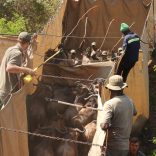Mozambique: Severe weather alerts can now be sent by SMS to help people at risk
Hundreds in Búzi queue for evacuation to Guara Guara – Noticias

Photo: Noticias
Hundreds of residents of the headquarters town of Buzi district, one of the parts of Sofala most affected by the winds and rains of Cyclone Eloise, were still late yesterday afternoon queuing for evacuation by boat to the Guara Guara administrative post, their houses either flooded or destroyed.
Those affected, including the elderly, women and young children, told ‘Notícias’ that they were queuing for a third consecutive day and feared that they would spend another night in the open, since the evacuation operations are being carried out under difficult conditions but must, according to the National Institute for Disaster Risk Management and Reduction (INGD), have safety as a first priority.
This is not the first time that Búzi has been flooded. In 2019, the headquarters town was practically submerged, with the water swallowing up several houses. But the population insists on staying, despite recommendations to move to high areas such as Guara Guara.
INGD President Luísa Meque, together with the governor and Secretary of State in the province, Lourenço Bulha and Stela Pinto Novo Zeca respectively, was in Búzi on Sunday afternoon, and reiterated the need for people to follow recommendations and leave the risk areas.
This time, evacuations from the town started on January 20, three days before the district was hit by Eloise, which in the early hours of Saturday brought winds of 120 and 150 km/h and more than 200 mm of rain in 12 hours.
Even so, Meque says, many of those now waiting for evacuation did not heed the call to leave. Indeed, the first evacuees had practically to be forced to move.
Meque said that many people went to their own homes elsewhere in the area, while others were in the accommodation centres set up there.
She said that it was extremely difficult to gauge the number of people waiting for transport, as more and more families kept arriving at the scene. She also regretted not being able to estimate how many days it would take to move them all.
Among the biggest difficulties is the difference in priorities between the INGD and those affected. While the authorities prioritise the removal of people, taking into account the primary objective of saving lives, the victims were trying to take with them the maximum amount of belongings, a situation slowing things down considerably.
Lourenço Bulha and Stela Zeca reiterated the need for people to move to higher, safer areas like Guara Guara once and for all, and break the cycle of seasonal suffering to which they are subjecting themselves.












Leave a Reply
Be the First to Comment!
You must be logged in to post a comment.
You must be logged in to post a comment.